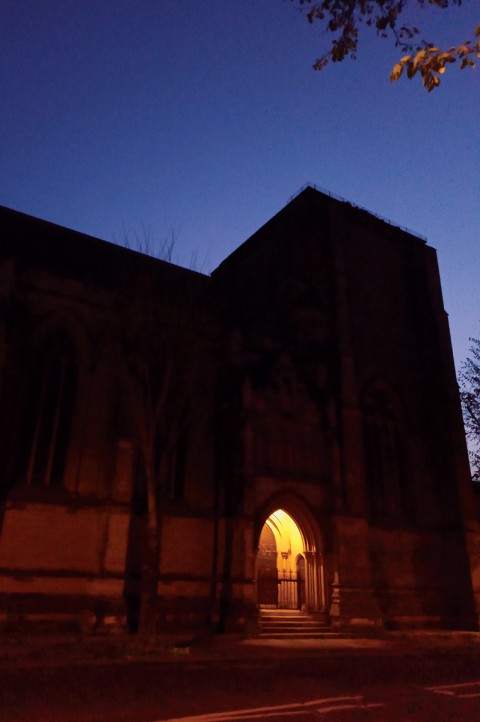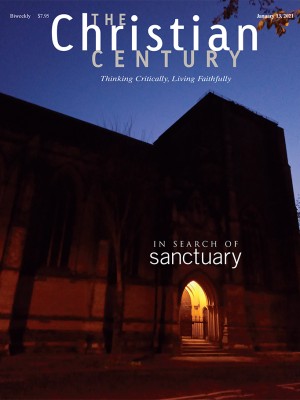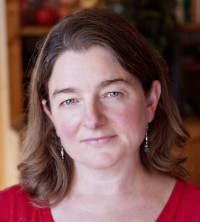In search of sanctuary
When my church opened its doors to an immigrant family, we had to reimagine the meaning of sacred space.

“There’s a family in sanctuary at St. George’s right now,” my priest texted me midmorning on an ordinary day in June. We had declared ourselves a sanctuary church four years earlier, but it wasn’t until this particular day that we had been called upon to act.
I biked over to the church as quickly as I could. The food pantry was open in the back, and a line of pantry visitors snaked down the sidewalk spaced six feet apart by traffic cones. Our church administrator sat on the front steps.
“I’m just sitting here,” she said, looking at me meaningfully. “Just in case. Just keeping my eye on things.” Despite the Trump administration’s nearly constant attack on immigrants, ICE activity in our community had been fairly quiet. But we tried to stay vigilant.
Read our latest issue or browse back issues.
Inside, the family sat in the dining room with the door closed. They had arrived earlier in the morning after an unmarked black van patrolled the manufactured home community where they live. A neighbor had understood their plight, borrowed a key from one of the pantry coordinators, and let them into the church before the pantry opened. There were five of them—a couple with three children, ages ten, seven, and four months. The pantry coordinator had brought them snacks and drinks and a box of toys, and the daughter was playing with Legos.
As the day unfolded, we came to understand that the family and their supporters did not have a plan—we were the plan, this was the plan, and no one who knew better was going to come and rescue us.
We had looked on the various organizational websites and taken our cues from the Sanctuary movement. We read the tool kit provided by the Unitarians; we called those who had been involved in sanctuary two hours east of us in Denver. We consulted at length with the American Friends Service Committee on the best path forward for the family. But we gradually understood that sanctuary, the meaning of it, was ours to find. There was no set of procedures, no set of answers, no way for someone else to tell us how to do this. Sanctuary, whatever that was, was right here, right now, being shaped by the choices we were all making by the minute.
Sanctuary is an ancient tradition that allows people who are being persecuted by civil authorities or who feel that they are likely to be unfairly treated to find, in churches and other religious communities, a safe space from which to consider their options. In our current context, it is intended to prevent the rush to judgment and deportation that currently destroys many lives in the United States. In the 1980s, churches in the United States began providing sanctuary for those who had fled wars in Central America and were being sent back into war zones without being given the chance to apply for asylum. In the most recent iteration of this movement, churches and synagogues have offered spaces to undocumented immigrants under deportation orders in order to enable them to pursue their cases using due processes of law. This has become necessary as immigration enforcement in this country has become haphazard and heavily reliant on fear, intimidation, and speed instead of on legal procedures.
At my church, we knew that there was no special legal status for sanctuary: sanctuary is a request, not a demand. We were relying on tradition to provide the necessary space and protection for the family. We had no legal right to prevent ICE agents or local law enforcement from entering the church. Nevertheless, I prepared my speech for ICE agents, if they were to come. “Of course you may come in,” I practiced. “Please be advised that you would be the first law enforcement officials to violate the tradition of sanctuary in Colorado’s history. I have all of the Denver news outlets on speed dial, and I will be filming you while you enter here.”
We also knew that in these early stages of sanctuary, the family was particularly vulnerable. They had yet to make any formal statements to anyone. They were calling lawyers and waiting for advice. They were trying to figure out how to make arrangements and safety plans for their children. All we could do was simply ask law enforcement for a pause in their rush to deport the family.
Meanwhile, we gave them as much autonomy as we could in arranging their living space, offering them what little privacy was available. We turned the church dining room into a bedroom and a sitting room. Community members brought beds, sheets, toys, and a crib. We showed the family how to use the stove and where to find food and coffee. We gave them towels for the shower.
Late that afternoon, we sat together on the steps of the altar with the father and he told us why he was seeking sanctuary. As he spoke we watched the patterns of the stained-glass windows move across the pews with the setting sun. When we left, his wife was scrambling eggs with ham for the children.
As the family settled in, we went about the life of the church, which during the pandemic meant opening the building to about 300 food pantry visitors a week.
Just a few months prior to the family’s arrival, I had looked around the room that I had always called the church’s “sanctuary” and seen it piled high with cardboard boxes and canned goods, strewn with the fine skins of onion peels and smelling faintly of rotting potatoes. I wondered where my sanctuary had gone. None of our usual Holy Week liturgies took place, and at the food pantry on Good Friday, I saw that the altar—normally stripped bare at the end of Maundy Thursday—remained decked with linens and other objects. So I stripped the altar by myself, after the food pantry closed, out of a desire to create some space apart from the hunger and fear and need that the pandemic had created in all of us.
Now, at the moment of the family’s arrival, the possibility of maintaining some small space of the sanctuary for this sacred apartness had become a conflict of personalities as well as a question about precisely where to put the cardboard boxes and extra crates of canned vegetables. Some people were upset that the sanctuary now looked like a warehouse. Other people argued that this was the real work of the church in a moment like this and the aesthetics didn’t matter. Together we were working toward a compromise.
But I found myself perplexed, amazed by and struggling with the multiple meanings of sanctuary—not the political meaning, necessarily, but the spiritual and social ones. How much should we protect the church sanctuary from the onslaught of these new demands on our space? How much should we give in to the piles of boxes that now surrounded us? I had walked myself into something of a false dichotomy. Which is more important: the potatoes or the altar?
Patrick Malloy, sub dean and canon for liturgy and the arts at the Episcopal cathedral in New York City, has designed award-winning church sanctuaries that play with the very questions that were plaguing me. He showed me the cover of a 2008 issue of Living Church magazine, a photo he took of a small church in Allentown, Pennsylvania, that housed people made homeless after a local fire. They had moved cots into the sanctuary, but the cots had been thoughtfully integrated into the worship space, keeping alive the sense of sacred holding. In the photograph, captioned, “This is none other than the House of God and the Gate of Heaven,” Malloy intentionally foregrounded the sanctuary lamp, which indicates that the reserved sacrament is present.
“The fact that people are sleeping here is not to say that it is no longer a church, but that the presence of Jesus in the sacrament is the presence of Jesus in these poor people,” Malloy told me. “You don’t have to give up one for the other. The bishop of the Diocese of Pennsylvania preached his sermon on this photograph on Easter of that year, and he basically said, if you can’t see Jesus in the people in the cots, you can’t see Jesus in the sacrament. But you do not desacralize the space. You have to maintain that tension.”
Christian sacred spaces are designed to hold two aspects of incarnational reality in tension with one another, Malloy explained. The immanent: God in the ordinary. The transcendent: God as more than any place or object. This is why he recommends keeping the altar area clear. “The minute you lose the sense of the transcendent,” he said, “the thing becomes a feeding program. . . . It is just pure immanence. God is more than the building, more than the people who come. You’ve got to find ways in an incarnational model to express that.”
Having the family in our church—people who were seeking a different kind of sanctuary—helped me see this incarnational model at work in our own space. It wasn’t just about how the space was used; it was about how to find the sacred pause in ourselves that we were trying to offer to the family.
In An Altar in the World, Barbara Brown Taylor argues against the idea of setting apart some particular space as sacred while consigning the rest of the space as secular. “Human beings,” she writes, “may separate things into as many piles as we wish—separating spirit from flesh, sacred from secular, church from world. But we should not be surprised when God does not recognize the distinctions we make between the two. Earth is so thick with divine possibility that it is a wonder we can walk anywhere without cracking our shins on altars.”
Taylor seems to be arguing that all spaces already exist in the tension Malloy described, and so there is no need to set apart some of them as sacred. But as I wrestled with what sanctuary might mean in light of the new situation at our church, I became acutely aware of two problems with what Taylor suggests. One was that my church was relying on the distinction between sacred and secular to keep this family safe. That fragile separation of “things into piles”—and the possibility that the sacred might be respected by secular authorities—was allowing us to proceed as we were. Without this distinction, there would have been nowhere for the family to run. There would be no sanctuary.
The other thing that troubled me was my own need. I could and often do find sanctuary out there in the world. There is a particular creek surrounded by an aspen grove near my house where I go to find solace, peace, and connection. But I also have a need for communal spaces that provide a sacred apartness. When I turn toward the altar at the front of the church, I know I am turning to a space that many others have turned to, and that has meaning.
Henri Nouwen wrote that he prayed better in places where a lot of prayers had been said. In a church sanctuary, when we yearn for connection between the Divine and the human, we draw upon the work that others have done. That doesn’t mean these are the only places that God is present. A place is set apart as holy not because other places are profane, but because the communal act of setting it apart creates meaning and endures through time, creating sanctuary for others as well as ourselves.
I realized that our church was poised to offer sanctuary because we had been practicing opening our doors to strangers for decades, through a weekly community meal and a food pantry. That meant not only practical things, like the family’s neighbor knowing who to ask for a key, but also spiritual things. We were practiced at holding space for others.
The family was with us for just over a month. The last day they spent at St. George’s was a difficult one. I arrived for my food pantry shift at 9 a.m. I had pulled ground beef, cheese, and tortillas from the refrigerator to make burritos for the day’s takeaway lunch when the father of the family asked if he could speak with me privately. He had just learned, he said, that he had been added to ICE’s ten most wanted list, and the local sheriff was calling his family members and making threats. Even though we were still waiting to hear back from a couple of lawyers, we wondered, not for the first time, if he and his family would be better able to pursue their case from Denver. All day long we talked with our partners there, with the Episcopal Diocese of Colorado, with the family and their support network. We reckoned with the threats. We debated their options. We reviewed our scripts and tools. We prayed. We tried to hold some space for the family while they worked through this new information.
By evening he was gone. The rest of the family stayed a few more days while he got settled in at a church in Denver and continued his quest.
Their sitting room was again the church dining room turned food packing and storage room. The squabbles about how to arrange the space continued. But now the space contained something new. The sanctuary we had created with the family was now there for all of us, documented and undocumented, English- and Spanish-speaking, those looking for food to feed their families, those looking for ways to stay safe in the pandemic, those looking for God or for a moment of peace.
And we finally knew what to do with the potatoes. We reorganized the sanctuary so that anyone who came in to receive food would be able to look up toward the altar and receive a little glimpse of the transcendent, and anyone who came in to worship could look around and see the messy work of God in the ordinary. Neither would be forgotten, and it would be our job to draw them together into something that we could call sanctuary.






